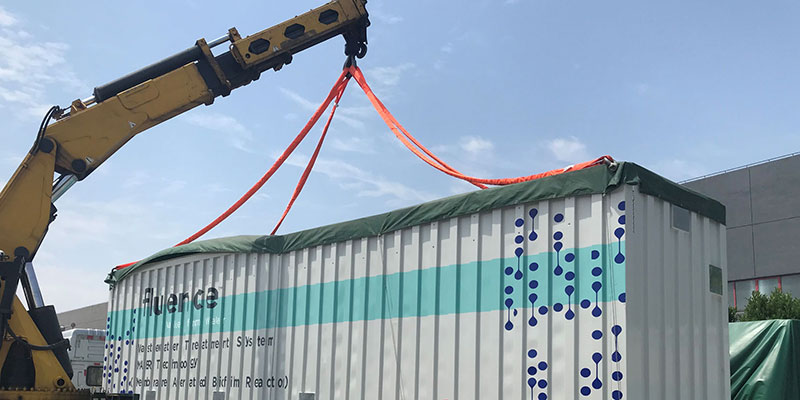
When containerized plants are used in decentralized systems, there’s no need to lay long pipelines to central treatment plants.
Whether you’re instituting treatment for the first time or replacing aging infrastructure, decentralized treatment with modular plants is making more and more sense
Around the world, countries are looking for effective water treatment and sanitation systems. In developing and underdeveloped countries, rapid urbanization and increased regulation is driving the new initiatives centered around building effective, resilient infrastructure.
While developed nations may have been known for ample water quality and sanitation in the past, their existing large-scale, centralized water and wastewater treatment infrastructure has begun to lag behind rising regulatory standards and the demands of a growing population.
In response to these trends, the use of decentralized treatment models is growing around the world, driving global growth in the market for containerized water and wastewater treatment systems, according to Frost & Sullivan, a market research and analysis firm.
Advantages of Decentralization
Decentralization of water infrastructure means installing smaller, well-scaled treatment plants at the source of need, and containerized units are ideal for the job. Containerized plants can quickly bring more capacity and raise water quality anywhere a shipping container can go in underdeveloped, developing, and developed regions alike. Decentralization can accomplish these goals without massive, centralized projects that require extensive planning and expensive pipelines. Without the hefty cost of pipeline infrastructure, often over 60% of CAPEX and OPEX can be saved by using decentralized infrastructure instead of centralized.
In rural or agricultural regions, containerized systems can be delivered quickly and operate where it’s not feasible to extend lengthy pipelines to distant centralized plants.
Another advantage – in water stressed areas, decentralized wastewater treatment provides a local source of water that can be reused for irrigation and other non-potable purposes. For example, hotels and resorts can save a lot of money by reusing treated wastewater for landscaping instead of buying drinking level quality water.
Frost & Sullivan also predicts that solar or renewably powered treatment systems will see wide adoption across sectors in the Middle East and Africa (MEA) and Latin America (LATAM) regions which lack water but have ample sunshine.
Containerized Treatment
Fluence specializes in containerized water and wastewater treatment plants.
For wastewater treatment and water reuse, Fluence harnesses the power of membrane aerated biofilm reactor (MABR) technology in its Aspiral™ line. MABR‘s single-tank nitrification-denitrification and passive aeration slash energy use and produce high-quality water that meets or exceeds California’s Title 22 and China’s Class 1A standards for non-potable applications like agricultural irrigation.
For desalination and freshwater purification, Fluence’s NIROBOX™ line uses up-to-date reverse osmosis technology to save energy and money.
In rapidly growing metro areas of the developed world, where space is at a premium, the small physical footprint of containerized units allows them to fit in more places. Low-odor, low-noise operation of Aspiral™ units makes them good neighbors even in tight urban quarters as they deliver high-quality water that’s safe for reuse in applications including pavement washing, landscape irrigation, and toilet flushing. Both Aspiral™ and NIROBOX™ units are modular, so they can be used individually or in tandem to increase capacity.
For customers who’d rather pay for wastewater treatment and reuse by volume rather than buying plants, Fluence offers Water Management Services using the build-own-operate model.
Market Growth for Decentralized Treatment
Frost & Sullivan projects that the global market for decentralized containerized or packaged systems will record a 7.2% compound annual growth rate from the $5.22 billion recorded in 2020 to an estimated $7.92 billion by 2026. The COVID-19 pandemic caused a transient growth dip of 2.2%, but full recovery to pre-pandemic levels is expected by year’s end.
The leading market for containerized and packaged systems is Europe. Asia-Pacific (APAC) showed the most significant growth and growth potential. LATAM and MEA also are exploring containerized and packaged systems.
Frost & Sullivan’s Paul Hudson said:
In two to five years, decentralized W&WWT systems will register a focused investment as part of smart city infrastructure to reduce the stress on centralized infrastructure. Further, from a solution-type perspective, both decentralized containerized/packaged WWT and WT systems will contribute roughly at the same rate to expedite the overall industry’s growth.
He also noted that water management services that incorporate waste-to-energy systems are expected to make major gains in North America and APAC in the coming two or three years. Fluence has numerous anaerobic digestion waste-to-energy systems in operation.
Fluence specializes in containerized units that can make decentralized treatment happen. Contact our experts to learn more about how to augment or replace aging, over-stressed infrastructure with an efficient decentralized system.
